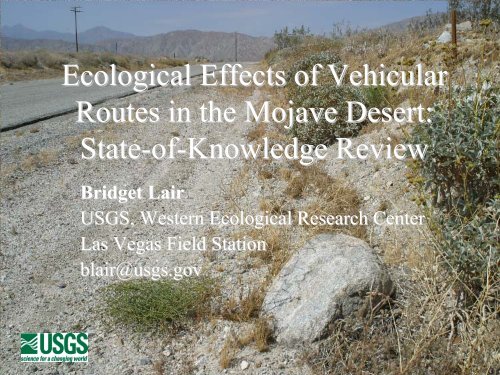Ecological Effects of Vehicular Routes in the Mojave Desert: State-of ...
Ecological Effects of Vehicular Routes in the Mojave Desert: State-of ...
Ecological Effects of Vehicular Routes in the Mojave Desert: State-of ...
Create successful ePaper yourself
Turn your PDF publications into a flip-book with our unique Google optimized e-Paper software.
<strong>Ecological</strong> <strong>Effects</strong> <strong>of</strong> <strong>Vehicular</strong><strong>Routes</strong> <strong>in</strong> <strong>the</strong> <strong>Mojave</strong> <strong>Desert</strong>:<strong>State</strong>-<strong>of</strong><strong>of</strong>-Knowledge ReviewBridget LairUSGS, Western <strong>Ecological</strong> Research CenterLas Vegas Field Stationblair@usgsusgs.govgov
Literature Document<strong>in</strong>g <strong>Effects</strong> <strong>of</strong><strong>Vehicular</strong> <strong>Routes</strong> <strong>in</strong> <strong>the</strong> <strong>Mojave</strong> <strong>Desert</strong>• Few quantitative analyses <strong>of</strong> one-or two-lane vehicular routes <strong>in</strong> <strong>the</strong><strong>Mojave</strong> <strong>Desert</strong>• Numerous studies document<strong>in</strong>g effects <strong>of</strong> Off Highway Vehicles• Many lack robust statistical design• Literature from o<strong>the</strong>r North American desert regions can beextrapolated for application <strong>in</strong> <strong>the</strong> <strong>Mojave</strong> with care
Types <strong>of</strong> <strong>Vehicular</strong> <strong>Routes</strong>•OHV trails– s<strong>in</strong>gle-track motorcycle– two-track 4-wheel drive• Local roads– unimproved dirt– improved dirt• Collector roads– improved dirt– gravel– paved• Arterial roads– <strong>State</strong> highways• Limited-accesshighways– Interstate freeway– toll roads
Comparisons Among <strong>Vehicular</strong> <strong>Routes</strong>Route CharacteristicsRoute typeSurfaceBermsShouldersFrequency<strong>of</strong> travelO<strong>the</strong>r factorsOHV trailsS<strong>in</strong>gle ortwo-trackdirtNoneNoneLowPervasive <strong>in</strong>wildlands, diffusedistributionLocal roads1-lane dirtLowNoneLowPervasive <strong>in</strong>wildlandsCollectorroads1 to 2-laneimproveddirt, gravel,or pavedHighNarrowModeratePervasive <strong>in</strong>wildlandsArterialroads2-lanepavedHighWiderHighFenc<strong>in</strong>g, culvertsLimitedaccesshighwaysMulti-lanepavedHighVery WideVery HighFenc<strong>in</strong>g, culverts,median
<strong>Vehicular</strong> <strong>Routes</strong> Effect PhysicalFeatures, Vegetation and WildlifeDirect• Geomorphology• Hydrology• Microclimate• Invasive Plants• Atmosphere• Mortality due to Construction /Traffic• FireIndirect• Habitat fragmentation– <strong>Ecological</strong> barriers,corridors, and filters• Changes <strong>in</strong> populations andcommunity structure• Access
<strong>Effects</strong> <strong>of</strong> <strong>Vehicular</strong> <strong>Routes</strong> onMammals <strong>in</strong> <strong>the</strong> <strong>Mojave</strong> <strong>Desert</strong>Garland and Bradley (1984)– Rodents were abundant with<strong>in</strong> approximately 30m <strong>of</strong> <strong>the</strong> highwaybut rarely crossed it– Suggest that wide roads may <strong>in</strong>hibit cross<strong>in</strong>gs– Found that size <strong>of</strong> home range did not effect proximity to highwayStarr (1998)– Access is critical component to resistance to human impacts <strong>in</strong>desert ecosystems– Ease <strong>of</strong> access results <strong>in</strong> high Cumulative Impact Rat<strong>in</strong>gs thatdecrease with <strong>in</strong>creas<strong>in</strong>g distance from <strong>the</strong> road, with no impactsfound 3-4 km from edge <strong>of</strong> development
<strong>Effects</strong> <strong>of</strong> Fenc<strong>in</strong>g <strong>Vehicular</strong> <strong>Routes</strong>Boarman and Sazaki (1997)– New and properly ma<strong>in</strong>ta<strong>in</strong>ed barrier fences are effective <strong>in</strong>reduc<strong>in</strong>g highway mortality <strong>of</strong> several species <strong>of</strong> vertebrates– Yet to determ<strong>in</strong>e if culverts reduce fragmentation caused byhighways and fencesBrooks (1995, 1999)– Abundance and species richness <strong>of</strong> birds and lizards were higher<strong>in</strong>side than outside DTNA. Abundance <strong>of</strong> black tailed hares waslower <strong>in</strong>side DTNA– Structural diversity <strong>of</strong> perennial plant community did not differ buttotal plant cover was 50% greater <strong>in</strong> protected areas– Greater abundances and species richness <strong>of</strong> vertebrates <strong>in</strong>side maycorrelate with abundance <strong>of</strong> seeds and <strong>in</strong>vertebrate prey
<strong>Effects</strong> <strong>of</strong> <strong>Vehicular</strong> <strong>Routes</strong> onVegetation <strong>in</strong> <strong>the</strong> <strong>Mojave</strong> <strong>Desert</strong>Hunter and Turner (1987)– Clear<strong>in</strong>g and construction replaced native annual plants with nonnativespecies E. cicutarium, S. arabicus and S. paulseniiJohnson et al., (1975)– Arterial verge cover was 17x higher, and improved dirt roadsidecover was 6x higher, than control areas– Species richness <strong>of</strong> annual plants was higher along verges,especially along paved roads– High density <strong>of</strong> annual plants along verges was due primarily to<strong>the</strong> natives A. tessellata and D. p<strong>in</strong>nata, and <strong>the</strong> aliens B. rubensand S. barbatus
<strong>Effects</strong> <strong>of</strong> Utility CorridorsLathrop & Archbold (1980)– Construction decreased productivity, diversity and stability <strong>of</strong>perennial vegetation– Measured <strong>in</strong>creases <strong>in</strong> non-native vegetation– Enhanced vegetation along road edges and slight <strong>in</strong>creases underpowerl<strong>in</strong>es and along trenches <strong>of</strong> pipel<strong>in</strong>esVasek et al. (1975)– Perennial plant density and cover were significantly higher on <strong>the</strong>dirt road verge than <strong>the</strong> control area away from <strong>the</strong> verge– Recovery <strong>of</strong> vegetation after utility construction may require am<strong>in</strong>imum <strong>of</strong> 30-40 years, likely longer
Chihuahuan and Sonoran <strong>Desert</strong>sLightfoot and Whitford (1991)– Compared plant cover along roadsides and 20m from <strong>the</strong> roadsides– Increased roadside creosote production– Foliage arthropod densities were higherRosen and Lowe (1994)– Measured roadside mortality <strong>of</strong> Sonoran <strong>Desert</strong> snakes– Counted 368 snakes (104 live, 264 dead) / 4 yrs / 15, 525 km– Estimated loss <strong>of</strong> 22.5/km/yr along 44km transect <strong>of</strong> paved road
Roads as Conduits for Exotic PlantInvasions: Colorado PlateauGelbard and Belnap (2003)– Compared plant cover along <strong>the</strong> verges and 165ft from <strong>the</strong> verges(“<strong>in</strong>terior sites”) <strong>of</strong> paved roads, improved dirt roads, and 4-wheeldrive tracks– Road improvement <strong>in</strong>creased cover <strong>of</strong> alien plants <strong>in</strong> roadsideverges– Road improvement also <strong>in</strong>creased alien plant cover <strong>in</strong> <strong>in</strong>terior sites.– In <strong>in</strong>terior sites, alien species richness was more than 50% greateralong paved roads and 30% lower along 4-wheel-drive tracks
What We do Know About <strong>Vehicular</strong><strong>Routes</strong> and <strong>the</strong> <strong>Mojave</strong> <strong>Desert</strong>• Road construction tends to decrease perennial plant cover and <strong>in</strong>creasecover <strong>of</strong> non-native annual species• Increase <strong>in</strong> vigor <strong>of</strong> roadside plants• Increase <strong>in</strong> some species <strong>of</strong> foliage arthropods at <strong>the</strong> road verge• Little research documents effects <strong>of</strong> vehicular routes on reptiles,amphibians or mammals
Directions for Future Research• Studies compare road verges with areas some distance away, butvery few have studied gradients• Few studies have evaluated <strong>the</strong> relative effects <strong>of</strong> different types <strong>of</strong>vehicular routes• Studies are needed to determ<strong>in</strong>e thresholds <strong>of</strong> route effects, anddevelop landscape models which are necessary for design<strong>in</strong>g bufferzones around vehicular routes• Roads can serve as barriers, corridors, and filters for plant andanimal dispersal and <strong>in</strong>vasions, but we know virtually noth<strong>in</strong>g abouthow <strong>the</strong>y affect species and communities <strong>in</strong> <strong>the</strong> <strong>Mojave</strong> <strong>Desert</strong>
















